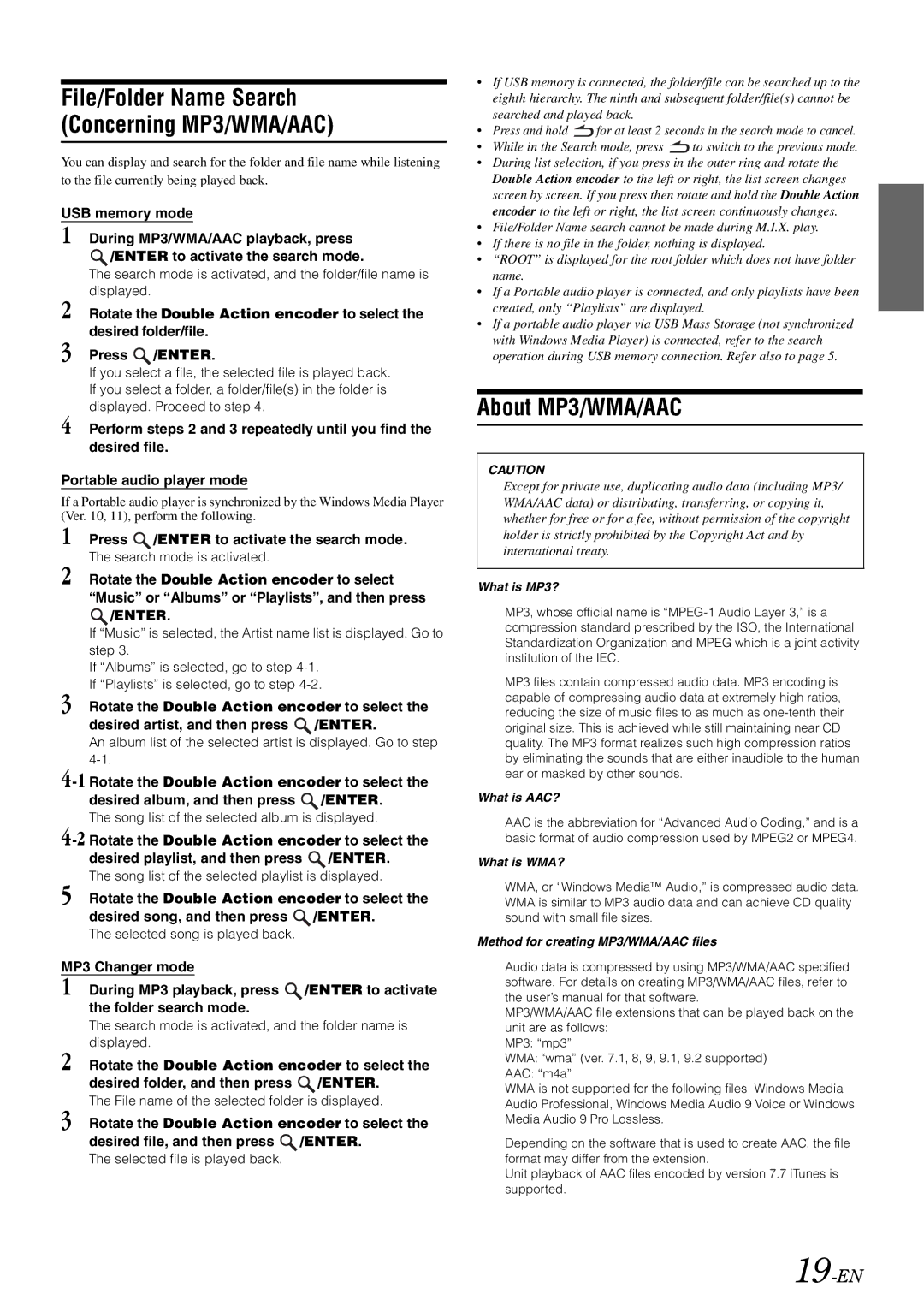
File/Folder Name Search (Concerning MP3/WMA/AAC)
You can display and search for the folder and file name while listening to the file currently being played back.
USB memory mode
1 During MP3/WMA/AAC playback, press ![]() /ENTER to activate the search mode.
/ENTER to activate the search mode.
The search mode is activated, and the folder/file name is displayed.
2 Rotate the Double Action encoder to select the desired folder/file.
3 Press ![]() /ENTER.
/ENTER.
If you select a file, the selected file is played back. If you select a folder, a folder/file(s) in the folder is displayed. Proceed to step 4.
4 Perform steps 2 and 3 repeatedly until you find the desired file.
Portable audio player mode
If a Portable audio player is synchronized by the Windows Media Player (Ver. 10, 11), perform the following.
1 Press ![]() /ENTER to activate the search mode. The search mode is activated.
/ENTER to activate the search mode. The search mode is activated.
2 Rotate the Double Action encoder to select “Music” or “Albums” or “Playlists”, and then press
 /ENTER.
/ENTER.
If “Music” is selected, the Artist name list is displayed. Go to step 3.
If “Albums” is selected, go to step
3 Rotate the Double Action encoder to select the desired artist, and then press ![]() /ENTER.
/ENTER.
The song list of the selected playlist is displayed.
5 Rotate the Double Action encoder to select the desired song, and then press ![]() /ENTER.
/ENTER.
The selected song is played back.
MP3 Changer mode
1 During MP3 playback, press ![]() /ENTER to activate the folder search mode.
/ENTER to activate the folder search mode.
The search mode is activated, and the folder name is displayed.
2 Rotate the Double Action encoder to select the desired folder, and then press ![]() /ENTER.
/ENTER.
The File name of the selected folder is displayed.
3 Rotate the Double Action encoder to select the desired file, and then press ![]() /ENTER.
/ENTER.
The selected file is played back.
•If USB memory is connected, the folder/file can be searched up to the eighth hierarchy. The ninth and subsequent folder/file(s) cannot be searched and played back.
•Press and hold ![]() for at least 2 seconds in the search mode to cancel.
for at least 2 seconds in the search mode to cancel.
•While in the Search mode, press ![]() to switch to the previous mode.
to switch to the previous mode.
•During list selection, if you press in the outer ring and rotate the Double Action encoder to the left or right, the list screen changes screen by screen. If you press then rotate and hold the Double Action encoder to the left or right, the list screen continuously changes.
•File/Folder Name search cannot be made during M.I.X. play.
•If there is no file in the folder, nothing is displayed.
•“ROOT” is displayed for the root folder which does not have folder name.
•If a Portable audio player is connected, and only playlists have been created, only “Playlists” are displayed.
•If a portable audio player via USB Mass Storage (not synchronized with Windows Media Player) is connected, refer to the search operation during USB memory connection. Refer also to page 5.
About MP3/WMA/AAC
CAUTION
Except for private use, duplicating audio data (including MP3/ WMA/AAC data) or distributing, transferring, or copying it, whether for free or for a fee, without permission of the copyright holder is strictly prohibited by the Copyright Act and by international treaty.
What is MP3?
MP3, whose official name is
MP3 files contain compressed audio data. MP3 encoding is capable of compressing audio data at extremely high ratios, reducing the size of music files to as much as
What is AAC?
AAC is the abbreviation for “Advanced Audio Coding,” and is a basic format of audio compression used by MPEG2 or MPEG4.
What is WMA?
WMA, or “Windows Media™ Audio,” is compressed audio data. WMA is similar to MP3 audio data and can achieve CD quality sound with small file sizes.
Method for creating MP3/WMA/AAC files
Audio data is compressed by using MP3/WMA/AAC specified software. For details on creating MP3/WMA/AAC files, refer to the user’s manual for that software.
MP3/WMA/AAC file extensions that can be played back on the unit are as follows:
MP3: “mp3”
WMA: “wma” (ver. 7.1, 8, 9, 9.1, 9.2 supported)
AAC: “m4a”
WMA is not supported for the following files, Windows Media Audio Professional, Windows Media Audio 9 Voice or Windows Media Audio 9 Pro Lossless.
Depending on the software that is used to create AAC, the file format may differ from the extension.
Unit playback of AAC files encoded by version 7.7 iTunes is supported.
